经典全面小学英语总复习.ppt
小学英语六年级总复习课件
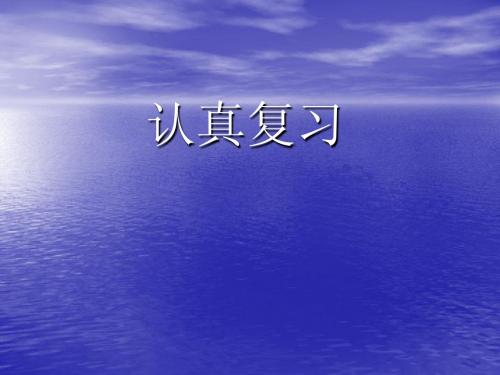
• 11、What’t in your box? 你的盒子里是什么? ——用于询问
盒子里有什么物品
别人的名字
Unit 4 Do you like peaches? 你喜欢桃吗? Yes, I do./ No, I don’t. 是的,我喜欢。/ 不,我不喜欢。 What about pears? 梨怎么样? I like them very much. 我非常喜欢它们。 3、 Let’s have some peaches and pears. 让我们买一些桃和梨吧。 4、 It tastes good. 它尝起来很好吃。 5、 Draw a peach. Colour it pink. 画一个桃子。把它涂成粉红色。 6、 Let me share with you. 让我和你一同分享吧! 7、 Sorry , I don’t like bananas. 对不起,我不喜欢香蕉。 8、 A: Can I have an apple,please? 请问我能吃一个苹果吗? Can I have a watermelon,please? 请问我能吃一个西瓜吗? Can I have some orange juice,,please? 请问我能喝一些橙汁吗? B: Certainly./ Sure. Here you are. 当然可以。/当然可以。给你。 9、 Have some more ? No , thank you. 再吃一些吧? 不,谢谢。 10、It’s cheap! 它很便宜! 11、I want some apples,bananas and oranges.我想要一些苹果、香蕉和橙子 12、I’m hungry./ I’m full. 我饿了。/ 我饱了。 13、Dog bag, please. No way! 请给我打包。 绝不可以。
PEP六年级下册英语总复习ppt课件

精选PPT课件
18
此课件下载可自行编辑修改,供参考! 感谢您的支持,我们努力做得更好!
精选PPT课件
19
此课件下载可自行编辑修改,此课件供参考! 部分内容来源于网络,如有侵权请与我联系删除!感谢你的观看!
此课件下载可自行编辑修改,此课件供参考! 部分内容来源于网络,如有侵权请与我联系删除!感谢你的观看!
精选PPT课件
16
六、连词成句
1.see , I , elephants , two (.) __I_s_e_e_tw__o_e_le_p_h_a_n_ts__. __________________ 2.what , park , big , a , nature (!) __W_h_a_t_a_b_ig__n_a_tu_r_e_p_a_rk__!________________ 3.good , are ,they , climbers (.) __T_h_ey__a_re_g_o_o_d__cl_im__b_er_s_.________________ 4.elephant ,water ,its ,is ,drinking ,that ,with ,trunk (?) _I_s_th_a_t_e_l_ep_h_a_n_t_d_r_in_k_in_g_w__a_te_r_w_i_th_i_ts__tr_u_n_k_?___________
精选PPT课件
8
变化规则
例词
1.一般词尾加-s
nurse-nurses、student-students book-books、map-maps……
2.以s、x、sh、ch结尾的名词一般在词 watch-watches、class-classes、
尾加-es
小学英语词汇总复习ppt课件

小学六年级总复习课件
`.
1
一、认识水果
苹果
香蕉
西瓜
2
一、认识水果
桔子
葡萄
桃子
3
一、认识水果
西红柿
草莓
梨
4
一、认识水果
菠萝
樱桃
5
二、认识人物、职业
安迪
天使
男孩
6
二、认识人物、职业
女巫/ 巫婆 驾驶员
男孩
7
二、认识人物、职业
裁缝 [teilə] 圣诞老人
百合花
8
二、认识人物、职业
蛋糕
面包
25
七、认识食物、食品
奶酪
巧克力
鸡蛋
26
七、认识食物、食品
汤
米饭
冰淇淋
27
八、认识动物
小鸡
鸟
一只猫
28
八、认识动物
鸭子
狗
大象
29
八、认识动物
鱼
猴子
熊猫
30
八、认识动物
老虎兔子猫31九、认识衣物连衣裙
鞋子
32
九、认识衣物 牛仔裤
夹克衫
帽子
33
九、认识衣物
衬衫/衬衣
鞋子
围巾
34
床头柜
17
四、认识学习用品及工具
铅笔
铅笔盒
橡皮
18
四、认识学习用品及工具
铅笔盒
铅笔刀/转笔刀
尺子
19
五、认识颜色
红色的
绿色的
蓝色的
20
五、认识颜色
黑色的
棕色的
蓝色的
21
五、认识颜色
黄色的
小学英语复习课件ppt

提供一些英文句子,让学生填写缺少的单词或短 语来完成句子。
改错题
提供一些有语法错误的句子,让学生找出错误并 改正。
04
阅读复习
阅读技巧提升
详细描述
理解句子结构:掌握英语句子的 基本结构,有助于理解长句子的 意思。
总结词:掌握阅读技巧
学会抓关键词:关键词通常代表 了句子的核心意思,通过抓关键 词能够快速理解句子大意。
按颜色类
如red, green, blue等。
单词词根复习
介绍常见英语词根,如dis, un, re等。
通过例词展示词根的应用和变 化。
练习题:让学生根据词根猜测 新单词的意思。
单词应用复习
单词造句
给出例句,让学生用刚复习的 单词造句。
情境对话
设定简单的情境对话,让学生 运用所学单词进行对话。
练习题
小学英语复习课件ppt
xx年xx月xx日
contents
目录
• 复习单元概述 • 单词复习 • 语法复习 • 阅读复习 • 写作复习 • 听力复习 • 口语复习
01
复习单元概述
复习内容介绍
写作
写一篇50-80字的短文,主题为“我的周 末计划”。
词汇
掌握200个基础词汇,了解其基本用法、 词性和例句。
语法应用实例
1 2
情境对话
提供一些实际场景,让学生运用所学的语法知 识进行对话练习。
故事编写
让学生运用所学的语法知识编写简单的故事, 提高语法应用能力。
3
翻译练习
提供一些中文句子,让学生用所学的语法知识 翻译成英文。
语法练习题
选择题
提供一些语法选择题,让学生通过选择正确答案 来检验自己的语法掌握程度。
PEP小学英语总复习 ppt课件
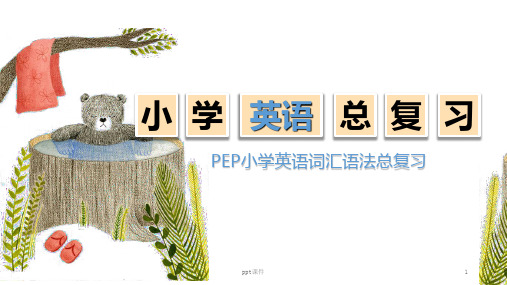
have a sore throat喉咙疼
ppt课件
26
数词(numbers): one一 two二 three三 four
23 (1)
四 five五 six六 seven七 eight八 nine九 ten
十 eleven十一 twelve十二 thirteen十三
fourteen十四 fifteen十五 sixteen十六
queen女王 visitor参观者 neighbour邻居
principal校长 university student大学生
pen pal笔友 tourist旅行者 people人物
robot机器人
ppt课件
7
职业(jobs):teacher教师 student学生
0 6 doctor医生 nurse护士 driver司机
hair头发 nose鼻子 mouth嘴 eye眼睛
02
ear耳朵 arm手臂 hand手 finger手指
03
leg腿 tail尾巴
颜色(colours):red红 blue蓝 yellow黄 green绿 white白 black黑 pink粉红 purple紫orange橙brown棕
ppt课件
小 学 英语 总 复 习
PEP小学英语词汇语法总复习
ppt课件
1
学习用品(school things):
pen钢笔pencil铅笔 pencil-case铅笔盒 ruler
尺子 book书 bag包 comic book漫画书
post card明信片 newspaper报纸 schoolbag
01
ppt课件
18
气象(weather): 15
小学英语复习课件

小学英语复习课件ppt xx年xx月xx日contents •复习计划与安排•词汇与表达复习•阅读理解复习•写作复习•听力与口语复习•文化与交际复习目录01复习计划与安排复习目标与内容涵盖小学阶段学习的基础词汇,包括名词、动词、形容词等。
词汇复习语法复习阅读理解听力训练重点复习简单句、并列句、疑问句等常用句型,同时兼顾时态、语态等语法知识。
选取适合小学生水平的短文,培养阅读技巧和快速阅读能力。
通过听录音、看视频等多种方式,提高英语听力水平。
复习计划与时间安排重点复习词汇和常用句型,进行大量听力和阅读练习。
第一周继续巩固词汇和语法知识,加强阅读和听力训练,适当加入写作和口语练习。
第二周进行综合性复习,将词汇、语法、阅读、听力等知识融合在一起进行练习,同时注重查漏补缺。
第三周进行模拟测试和考前冲刺,针对学生薄弱环节进行强化训练。
第四周注重讲解与练习相结合,让学生在实际操作中掌握知识和技能。
精讲多练通过对重点词汇和句型的复习,带动其他知识点的学习和运用。
以点带面将口语、听力、阅读和写作等技能融为一体,提高学生的综合运用能力。
听说读写全面发展及时批改学生作业,发现学生存在的问题,并给予针对性的指导和帮助。
注重反馈复习策略与技巧02词汇与表达复习复习apple、banana、orange、grape、pear、pineapple 等水果单词。
水果词汇复习描述水果颜色、形状、口感等的形容词和短语,如"a red apple"、"a sweet grape"、"a juicy peach"等。
表达水果词汇与表达颜色词汇复习red、blue、green、yellow、black、white等基本颜色词汇。
表达复习描述颜色的形容词和短语,如"a green shirt"、"a yellow sunflower"、"a black car"等。
PEP小学英语语法总复习及练习ppt课件
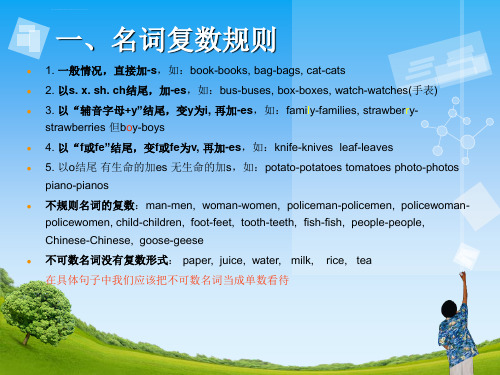
基本结构:主语+be not + 动词ing. 如: I am not eating. ● 现在进行时的一般疑问句
基本结构: be动词 +主语 +动词ing. 如: Are you eating? ● 现在进行时的特殊疑问句
policewomen, child-children, foot-feet, tooth-teeth, fish-fish, people-people, Chinese-Chinese, goose-geese ● 不可数名词没有复数形式: paper, juice, water, milk, rice, tea 在具体句子中我们应该把不可数名词当成单数看待
为深入学习习近平新时代中国特色社 会主义 思想和 党的十 九大精 神,贯彻 全国教 育大会 精神,充 分发挥 中小学 图书室 育人功 能
二、一般现在时
● 一般现在时的功能 1.表示事物或人物的特征、状态。如:The sky is blue.天空是蓝色的。 2.表示经常性或习惯性的动作。如:I get up at six every day.我每天六点起床。 3.表示客观现实。如:The earth goes around the sun.地球绕着太阳转。
为深入学习习近平新时代中国特色社 会主义 思想和 党的十 九大精 神,贯彻 全国教 育大会 精神,充 分发挥 中小学 图书室 育人功 能
● 写出下列各词的复数
I _w_e__him _th_e_m_this _th_e_se__ her _t_he_ir___
child _ch_il_dr_e_n photop_h_ot_o_es diaryd_i_ar_ie_sday_d_a_ys__ foot_fe_e_t _book_b_oo_k_sdress_dr_e_ss_e_s tooth__te_e_th___ sheep __sh_e_ep__box_b_o_xe_s_peach_p_ea_c_h_es_ man_m_e_n__ woman_w_om__en_ paper__p_a_pe_r__ juice__ju_ic_e__ water____wa_t_er__ milk___m_il_k__
小学英语复习课件

单词复习
总结词
记忆和辨识单词,掌握基本单词的词性和含义
详细描述
通过单词卡片、单词墙和单词游戏等方式复习单词,教授一些记忆技巧,如联想 记忆和词根记忆等。同时强调对基本单词的词性和含义的掌握,如名词、动词、 形容词等。
单词应用
总结词
应用单词于实际情境,进行简单的对话和交流
详细描述
通过角色扮演、模拟对话和小组讨论等方式复习单词,教授一些简单的口语表达方式,如问候、介绍和告别等。 同时强调在真实情境中应用所学单词进行简单的对话和交流。
描述事物
学习描述事物的常用表达方式,如颜 色、形状、大小等。
表达日常需求
学习表达日常需求的常用表达方式, 如购物、出行、就餐等。
讲述故事
学习讲述故事的常用表达方式,如时 间、地点、人物等。
情景对话练习
问候和告别
感谢和道歉
学习如何用英语进行问候和告别,如 “Hello”和“Goodbye”。
学习如何用英语表达感谢和道歉,如 “Thank you”和“I’m sorry”。
写作技巧复习
3. 选词造句
选择恰当的词汇和语法结构,组成通顺 的句子,表达自己的观点和想法。
5. 检查修改
完成初稿后,仔细检查语法、拼写、 标点等方面的错误,并进行修改和完
善。
4. 段落过渡
在段落之间合理使用过渡词和连接词 ,使文章更加连贯和流畅。
写作练习
给出几个主题,让学生根据所学的写 作技巧进行写作练习,如命题作文、 看图写话等。
句子结构复习
主语+谓语
介绍简单句子的基本结构 ,如“I am a student.” (我是学生。)
主语+谓语+宾语
pep人教版小学英语四年级总复习ppt课件
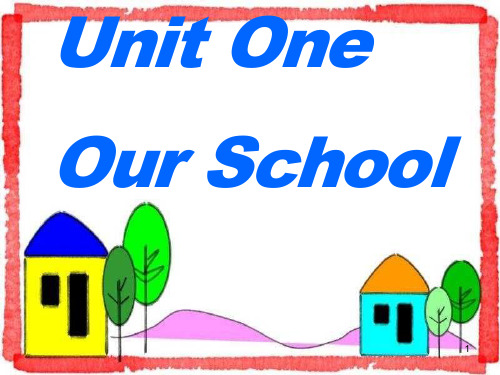
What are these? They are carrots. Are these cucumbers? Yes, they are. Are those onions? No, they aren’t.
How many sheep are there? There are 12.
How many books do you have?
I have eight.
6
Unit Three
Is this your skirt?
7
jacket shirt
skirt dress sweater T-shirt red
blue
green white jeans socks shoes shorts colour
18
四会句子
19
This is your computer.
That is your computer.
Is this teacher’s desk? Yes, it is.
What time is it? It’s two o’clock.
It’s 9:45. It’s time for math class.
How much are they? They’re three yuan.
Are they ducks? No, they aren’t.
How many horses are there? Twelve.
20
8
I like the white sweater with the green skirt. Where is my skirt? It’s on the bed. What colour is it? It’s blue. Is this your skirt? Yes, it is./No, it’s not.
PEP小学六年级下册英语总复习ppt课件
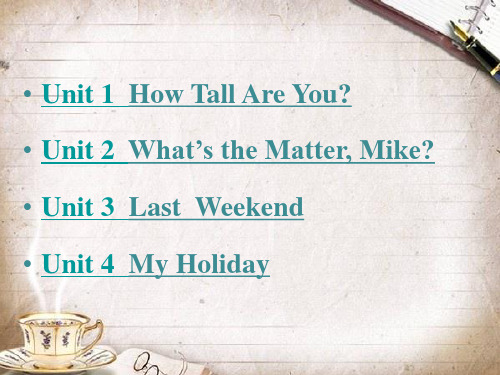
在整堂课的教学中,刘教师总是让学 生带着 问题来 学习, 而问题 的设置 具有一 定的梯 度,由 浅入深 ,所提 出的问 题也很 明确
三、填空 1. She is _____________(tall) than me . 2. How ________ (heavy) are you ? 3. My hands are __________ (big) than
yuan. (5) How many apples are there in the
bag? There are 5. (6) How heavy is the fish? It's 2kg.
many big much hea学中,刘教师总是让学 生带着 问题来 学习, 而问题 的设置 具有一 定的梯 度,由 浅入深 ,所提 出的问 题也很 明确
在整堂课的教学中,刘教师总是让学 生带着 问题来 学习, 而问题 的设置 具有一 定的梯 度,由 浅入深 ,所提 出的问 题也很 明确
Sore和hurt 的区别: (1)sore是形容词,意为“疼痛的”前面要加be
动词。 用来修饰名词,指的是身体某一部位的酸 痛 eg : sore throat. (2) hurt 意为“疼痛”受伤、刺痛、是实义动词。 如:He hurts his leg.他伤了腿。还可以说“His leg hurts.”他腿疼。
形容词
tall
short
old
比较级
taller shorter older
young
younger
一般直接在词尾
+ er
在整堂课的教学中,刘教师总是让学 生带着 问题来 学习, 而问题 的设置 具有一 定的梯 度,由 浅入深 ,所提 出的问 题也很 明确
小学英语语法复习完整ppt课件

3、用法:
①用于指代物品所属的词
②形容词性物主代词后需加名词,不可单独使用
③名词性物主代词后不加名词,可单独使用
.
7
小学英语语法
代词篇
人
称 主格
代 词
宾格
我 我们 你 你们 他 她 它
I we you you he she it me us you you him her it
含有be动词的句式变化 肯:主语 + be + 其他。
IHeamisaahtaepapcyhesrt.udent. 否:主语 + be + not + 其他。
IHeamisnnoottaahtaepapcyhesrt.udent. 讲义共享 问:Be + 主语 + 其他?
AIsreheyoautaeahcahpepry?student? 答:Yes, 主语 be. / No, 主语 be not.
fast _f_a_s_te_r_ late _l_a_te_r__ early _e_a_r_li_e_r__
.
13
小学英语语法
❖ 二、根据句意填入单词的正确形式。 ❖1. My brother is two years _o_l_de_r_ (old)
than me. ❖2. Tom is as __fa_t__ (fat) as Jim. ❖3. Is your sister _y_o_u_ng_e_r_ (young) than you? ❖4. Who is _t_h_in_n_e_r_ (thin), you or Helen? ❖5. Mary is not as _t_a_ll_ (tall) as the other girls. ❖6.My eyes are _b_i_g_ge_r_ (big) than _h_er_s_ (she).
PEP小学英语总复习ppt课件
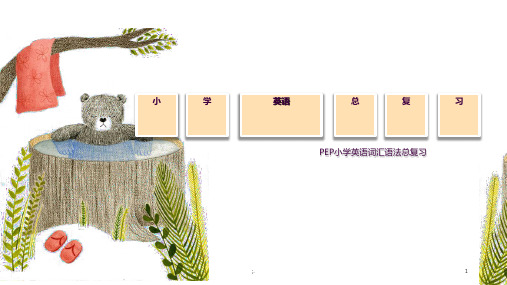
;.
13
地点(locations):home家 room房间 bedroom卧室 bathroom卫生间 living
room起居室 kitchen厨房 classroom教室 school学校 park公园 library图书馆
post office邮局 police office警察局 hospital医院 cinema电影院 bookstore书
city城市 hometown家乡 bus stop公交车站
;.
15
课程(classes):
13
sports体育运动 science科学
Moral Education 思想品德课
Social Studies社会课
Chinese语文 math数学
PE体育课 English英语课
;.
16
国家、城市(countries & cities):
;.
3
动物(animals):cat猫 dog狗 pig猪 duck鸭 rabbit兔 horse马 elephant大 象 ant蚂蚁 fish鱼 bird鸟 eagle鹰 beaver海狸 snake蛇 mouse老鼠 squirrel松鼠 kangaroo袋鼠 monkey猴 panda熊猫 bear熊 lion狮子 tiger老虎 fox狐狸 zebra斑马 deer鹿 giraffe长颈鹿 goose鹅 hen母鸡 turkey火鸡 lamb小羊 sheep绵羊 goat山羊 cow奶牛 donkey驴 squid鱿鱼 lobster龙虾 shark鲨鱼seal海豹 sperm whale 抹香鲸killer whale虎鲸
小
学
英语
总
复
人教精通版小学英语六年级下册总复习课件ppt
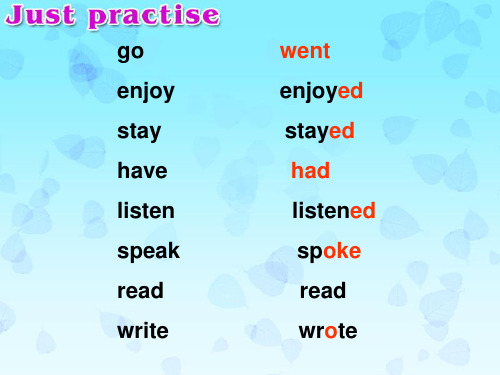
A.little B.few
C.lot
经营者提供商品或者服务有欺诈行为 的,应 当按照 消费者 的要求 增加赔 偿其受 到的损 失,增 加赔偿 的金额 为消费 者购买 商品的 价款或 接受服 务的费 用
十一、小练笔。 请你写一篇日记。
内容提示:假设今天是3月16日,星期日,你上午和 朋友一起去看电影、玩足球,下午和妈妈一起去逛街, 并买了一本新故事书,晚上回家看书。这一天你过得很 愉快。
经营者提供商品或者服务有欺诈行为 的,应 当按照 消费者 的要求 增加赔 偿其受 到的损 失,增 加赔偿 的金额 为消费 者购买 商品的 价款或 接受服 务的费 用
八、按要求完成下列各题。
1. they(反身代词)__t_h_e_m_s_e__lv_e_s 2.of course (同义词)____s_u__r _____
七、根据答句写问句。 1.— __W_h_e_r_e__ __w_e_r_e___ ____y_ou last year? —I was in Beijing last year. 2.—___H__ow___ ____w_a_s__ ___y_o_u_r__ holiday? —My holiday was interesting. 3.—___D_i_d___ ___s_h_e___go to Sanya? —Yes,she did.
- 1、下载文档前请自行甄别文档内容的完整性,平台不提供额外的编辑、内容补充、找答案等附加服务。
- 2、"仅部分预览"的文档,不可在线预览部分如存在完整性等问题,可反馈申请退款(可完整预览的文档不适用该条件!)。
- 3、如文档侵犯您的权益,请联系客服反馈,我们会尽快为您处理(人工客服工作时间:9:00-18:30)。
buses, box-boxes, watch-watches ②以“辅音字母+y”结 尾得词,变y为i, 再加-es,如:family-families, babybabies ③以“f或fe”结尾,变f或fe为v, 再加-es,如: knife-knives,wife-wives ④不规则名词复数: man-men, woman-women, policeman-policemen, policewomanpolicewomen, mouse-mice,child-children, foot-feet, tooth-teeth, fish-fish, sheep-sheep people-people, Chinese-Chinese, Japanese-Japanese
课件
练习
8. Are these ___th_e_ir____ tickets? No, __t_h_ei_rs____ are not __t_h_em_____. __T_h_e_irs____ aren’t here. ( they ) 9. I have a lovely brother. ____H_e ____ is only 3. I like ___h_im_____ very much. ( he ) 10. ____S_he____ is my aunt. Do you know ___h_e_r ____ job? ___S_h_e____ a nurse. ( she ) 11. So many dogs. Let’s count ___t_he_m____. ( they ) 三、用am, is, are 填空 1. I __a_m___ a boy. ___Ar_e__ you a boy? No, I __a_m__ not.
时间或空间上较远的人或者事物。例如: This is a pen and that’s an eraser. 这是一支笔,那是块橡皮擦。 This is a boy and those are girls. 这是个男孩,这些是女孩。 当指示代词所指的事物已确定时,后面的指示代词则用it或they代
When do you get up?
Which(哪一个)
When is your birthday? Which is your watch, the yellow one or the white one?
I’m reading.I played basketball.I’m going to do homework.
课件
代词
一、人称代词和物主代词 1、人称代词有主格和宾格的区别:主格通常位于句中第 一个动词之前,宾格一般位于动词或介词之后。 2、物主代词有形容词性与名词性的区别:形容词性用时 后面一般要带上词,名词性则单独使用,后面不带名词。 3、指示代词 共有四个:this,that,these,those。this 和 that 用于指代单数,these和 those用于指代复数。 4、疑问代词 一般用来构成特殊疑问句,常见的疑问代词 有who(谁),when什么时候),where(哪里),what(什 么),how(怎样) ,which(哪一个)等等。
课件
2. The girl___is___ Jack's sister. 3. The dog ___i_s ___ tall and fat. 4. The man with big eyes ___i_s___ a teacher. 5. You, he and I __a_r_e__ from China. 6. Where ___is__ your mother? She ___is___ at home. 7. Mike and Liu Tao __a_re___ at school. 8. Whose dress ___is___ this? 9. Whose socks ___a_re__ they? 10. That __i_s___ my red skirt.
课件
形容词:用于修饰名词,通常置于名词前
课件
不规则变化的形容词: little / few(原形) - less (比较级)- least(最高级) good(原形) - better(比较级) - best(最高级) bad (原形) - worse(比较级) - worst(最高级 )
课件
情态动词:情态动词用在行为动词前,表示说话 人对这一动作或状态的 看法或主观设想
情态动词无人称和数的变化,情态动词后面跟的动词须用 原形,否定式构成是在情态动词后面加 "not"。个别情态 动词有现在式和 过去式两种形式,过去式用来表达更加 客气, 委婉的语气,时态性不强,可用于 过去, 现在或 将来。 情态动词数量不多,但用途广泛,主要有下列: can (could),may (might),must,need,shall (should), will (would)
课件
介词
下面就时间概念的介词用法做一简要介绍和比较。
1. at (1)表示时间概念的某一个点。(在具体的某一时刻和时段等) at night ; at
6:00 (2)表示在某一具体地点(小地点)。如at the bus stop ,at home
2. on (1) 在······上面(表面接触;长在上面)。如on the chair,on the tree
肯定回答:Yes,he is. 否定回答:No,he is not(isn't).
课件
Be动词
课件
课件
特殊疑问句:以特殊疑问词开头,对句中某一 成分提问的句子
What are you doing?What did you do yesterday?What are you going to do?
课件
一般疑问句:是疑问句的一种。它是只用yes(是) 或no(否)来回答的句子。
其结构是: 系动词be/助动词/情态动词+主语+其他成分 通常回答为:
肯定:Yes,主语+提问的系动词be/助动词/情态动词. 否定:No,主语+提问的系动词be/助动词/情态动词的 否定形式. 例如:Is he a teacher?
替。如: This (suit) is expensive, isn't it? 这套衣服昂贵,不是吗? "Are those yours?" "Yes, they are." “那些是你的吗?”“是的,
它们是我的。
课件
疑问代词:一般用来构成特殊疑问句
常见的疑问代词有who(谁)when(什么时候),where (哪里),what(什么),how(怎样) ,which(哪一个) 等等。
课件
练习
用所给词的适当形式填空
1. That is not ___m_y_____ kite. That kite is very small, but __m__in_e____ is very big. ( I ) 2. The dress is ___h_e_rs____. Give it to ____h_e_r___. ( she ) 3. Is this ___y_o_u_r___ watch? (you) No, it's not ___m__in_e___ . ( I ) 4. ___H__e____ is my brother. ___H_i_s____ name is Jack. Look! Those stamps are ____h_is____. ( he ) 5. ____O_u_r___ dresses are red. (we) What colour are ___y_o_u_rs___? ( you ) 6. Here are many dolls, which one is ___h_e_r_s___ ? ( she ) 7. I have a beautiful cat. ___It_s_____name is Mimi. These cakes are ____i_ts____. ( it )
(2)在某天的上午、下午或晚上。如:on Monday ,on Tueday moring
3.in (1)在······里面。如:in the box
(2)在一段时间里。如:in the moring (3)在某一年份、季节、月份。如:in 2014,in October,in summer (4)在······上(外来)如:There is a cat in the tree.
What (问什么事,什么物或什么工作)
What colour(问颜色) What time(时间)
when(什么时候)
What is that? What is she?(What’s her job?)
What colour is your coat? What time is it?What’s the tim_e ___ him ___th_e_y __ this __t_ha_t ___ her __t_he_y__ watch _w_a_tc_h_e_s _child _c_h_ild_re_n_that ___th_os_e__ photo___ph_o_to_s _ day__d_ay_s___ sandwich_s_a_nd_w_ic_he_s_ boy___bo_y_s __dress__d_re_ss_e_s _tooth___te_et_h__sheep_s_h_e_ep__ box__b_ox_e_s__man__m_en___woman__w_om_e_n__ toy__to_ys____ family__fa_m_il_ie_s _
